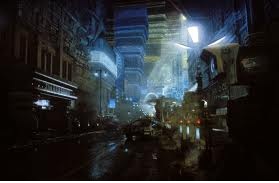In modern cinema, German Expressionist themes and
aesthetics are commonly reproduced in horror, fantasy and sci-fi films. Ridley
Scott’s Blade Runner (1982) is
reminiscent of Fritz Lang’s Metropolis
with its cold and dark futuristic city setting (as shown in Figure 5.01 & Figure 5.02). The contrast
of the higher city for the privileged and the lower city accommodating the commoners
is also similarly presented (Kellner, Leibowitz,
& Ryan, 2005). The film discusses the identity crisis faced by
humans and androids in relation to the German Expressionist theme of
self-analysis and features a corrupt world of capitalism where powerful
organization like Tyrell Corporation plays the role of the social oppressor. The
androids revolt against the authority and refuse to be terminated.
Figure
5.01 Blade Runner
vs
Figure 5.02 Metropolis
Dramatic shadowing evident of German Expressionist
influence is prevalent throughout the film (Figure 5.03) and hard backlights
are used extensively to create silhouettes (Figure 5.04) to shroud the story in
a sense of mystery (Ron, 2011). Night
scenes are lighted through windows to cast slanted shadows of lines onto the
subject (Figure 5.05).
Figure 5.03 Use of chiaroscuro lighting to create dramatic shadow
Figure 5.04 Silhouettes created with backlight
Figure 5.05 Lines as shadows
Lines and geometric shapes emphasized in German
Expressionism make prominent architectural features of the buildings (Figure
5.06). Gothic make-up is observed in the notorious android, Pris (Figure 5.07)
while Rachel, an advanced android takes the typical Noir’s femme fatale image
with red lipstick, shoulder pads and the cigarette (Figure 5.08).
Figure 5.06 Lines and shapes in building
Figure 5.07 Pris and her dark, gothic make-up
Figure 5.08 Rachel and her femme fatale look
In Tim Burton’s Edward
Scissorhands (1990), Edward Scissorhands’s gothic character design shows a
striking resemblance to Cesare of The
Cabinet of Dr. Caligari (Figure 5.09) and his hands are extension to the
claw-like fingers of Count Orlok of Nosferatu
(Figure 5.10).
Figure 5.09 Cesare vs Edward Scissorhands
Figure 5.10 Count Orlok vs Edward Scissorhands
Edward Scissorhands borrows from The Cabinet of Dr. Caligari in telling
the story of an outsider in a town where his existence is rejected. However,
the film seeks to recast the outsider as the hero and the townspeople as the
villain by contradicting common expectation (natural setting), portraying the
madness and corruption in a world where the beautiful is evil and the ugly is
kind-hearted (German Expressionist Films, 2010).
Lines and curves are seen in the structure of the neighbourhood in which roads
and pathways are all winding (Figure 5.11). Edward’s castle comes with a dark,
gothic design (Figure 5.12) with the garden plants cut into odd shapes of
animals.
Figure 5.11 Roads and pathways in the suburb
Figure 5.12 Edward’s gothic castle
Tim Burton had employed German Expressionist themes
and aesthetics across his films to create stylized and surreal fashion. Lines
and stripes in German Expressionism are favoured and can be spotted in some of
his films for example, the costume of Beetlegeuse in Beetlejuice (Figure 5.13), Jack Skellington’s attire in Nightmare Before Christmas (Figure 5.14)
and Sweeney Todd and Mrs. Lovett’s beach-wear (Figure 5.15) in Sweeney Todd: The Demon Barber of Fleet
Street (Why We Love Time Burton Films, n.d.)
Figure 5.13 Striped coat of Beetlegeuse in Beetlejuice
Figure 5.14 Jack Skellington in Nightmare Before
Christmas
Figure 5.15 Sweeney Todd and Mrs. Lovett’s striped
beach-wear
German Expressionism gives unique thematic and visual
styles to films as it allows for dramatic confrontation to reality in its
emphasis to distortion and madness. In our next post, we will again examine the
influence of German Expressionism on contemporary films by analyzing modern
sci-fi film, The Matrix by Larry and
Andy Wachowski.
References
German Expressionist Films. (2010, April 26). Retrieved April 3, 2012, from The Lies
and The
Laughter:
http://caseymensing.blogspot.com/2010/04/german-expressionist-film.html
Kellner, D., Leibowitz, F., & Ryan, M. (2005). Blade Runner A
diagnostic critique. Retrieved
April 1, 2012, from Jump Cut: A Review of
Contemporary Media:
http://www.ejumpcut.org/archive/onlinessays/JC29folder/BladeRunner.html
Ron. (2011, April 25). The Cinematography of "Blade Runner".
Retrieved April 3, 2012, from
Flooby Nooby:
http://floobynooby.blogspot.com/2011/04/cinematography-of-blade-
runner.html
Why We Love Time Burton Films. (n.d.). Retrieved April 4, 2012, from Hubpages:
http://maddartist.hubpages.com/hub/Why-We-Love-Tim-Burton


















No comments:
Post a Comment